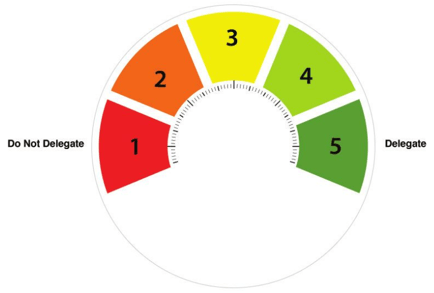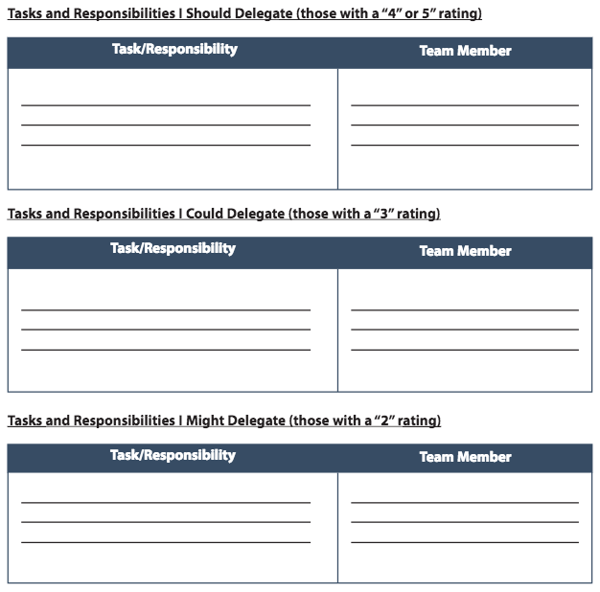Why to Delegate

Most leadership roles involve a variety of tasks that — simply put — cannot all be completed by one person. Sometimes leaders feel they must take up the reins of all of these tasks themselves to ensure they are done properly.
On the contrary, delegating some of these tasks to employees can improve task efficiency and benefit the organization in ways that aren't obvious at first. A study by Harvard Business Review determined that delegating can actually increase the income and overall efficiency of organizations. Not only does delegating empower others in the organization, it helps optimize the performance of the group. The more members who are included in the ownership of projects, the more efficient your organization will become.
Don’t know where to begin? Let's walk through delegating from start to finish. Feel free to download the delegating template to help you follow along with this blog.
Although optional, this template will help you take home what you've learned from this blog
When to Delegate
Before diving into how exactly to delegate, it's important to know when you should start delegating tasks. Here are some signs that you need to start delegating some of your tasks and projects:
- You simply don't have time to complete all of the tasks laid out before you
- Someone else at the organization is better suited for a task
- You would like to help a team member gain more experience in a certain area
- New more important priorities surface, and you'd like to re-structure your time
How to Delegate
Delegating isn't something that comes naturally to most people, which is why we created our delegating template to help you through it. Follow these steps to become a better delegator, and to optimize how you use your time.
Delegation Step 1: List Your Responsibilities
 First things first: think about all the tasks and job responsibilities you have to complete on a daily, weekly, and monthly basis. What are your responsibilities as a leader? What long-term projects and goals do you have? Figuring out how to delegate starts with determining what to delegate.
First things first: think about all the tasks and job responsibilities you have to complete on a daily, weekly, and monthly basis. What are your responsibilities as a leader? What long-term projects and goals do you have? Figuring out how to delegate starts with determining what to delegate.
Start at a high level with a list of monthly or quarterly goals that you want to accomplish. Then, break those larger goals down into smaller steps, listing the daily and weekly tasks needed to achieve the bigger objectives.
Next, list the tasks you do frequently, on a daily or weekly basis. This might include pulling reports, scheduling, answering emails, or conducting staff meetings and conference calls. Completing this exercise alone can be quite helpful, as it gives you a general sense of how your job requirements translate into daily activities.
This is the first step toward effective delegation. Once you have a comprehensive running list of all your tasks and responsibilities, it’s easier to determine what can and should be delegated.
Delegation Step 2: Choosing Delegation Authority
Once you have a full list of all your tasks and responsibilities, you will assign a level of delegation authority to each one. All team leader tasks fall along a scale of 1 to 5 representing the ability for that task to be delegated out to others.
Below is a brief description of what each level of the delegation authority scale means:
- Level 1 is a task that team leaders must complete on their own. (For example, team leaders should never delegate team member evaluations, salary discussions, rewards, discipline, and terminations.)
- Level 2 is a task that team leaders should do but that team members could assist them in doing if needed.
- Level 3 is a task that team leaders can do, but other team members can do as well if given the opportunity.
- Level 4 is a task that team members should do (i.e. – should be delegated to them) but team leaders can help them in an emergency.
- Level 5 is a task that team members must do.
Go through your list of tasks and assign each task a delegation level from 1 to 5. Next, you’ll be able to determine what to delegate.
Delegation Step 3: Determining What to Delegate
Based on the “Level of Authority for Delegation” rating you gave each responsibility, organize your tasks and responsibilities into the appropriate category below. Divide tasks into those tasks a team member should complete (“4” or “5”), tasks you could have a team member complete with help (“3”), and tasks you might delegate to a team member as a growth opportunity, which may require your assistance (“2”).

After determining what you should and could be delegating, the next step involves deciding which team member you should assign the responsibility.
Delegation Step 4: Deciding to Whom to Delegate
How do you know who you should delegate certain tasks to? It’s important to consider the following factors when deciding to whom to delegate:
- Delegate to team members who have the experience to do the job, as well as team members who have potential to learn to do the job.
- Other factors can also play in to who might be the best fit. Sometimes attitude, personality and aptitude need to be taken into consideration.
- Consider each team member’s workload, and who has time to take on extra responsibilities.
- Avoid delegating to the most capable or the same person on a team all the time since it can create a lopsided workload. Those who need the experience may not get it, and you can penalize your best workers by consistently giving them more assignments.
The questions below can be used as a guide to help you determine who might be the best fit to complete each responsibility:
- Who can do the task better than I can?
- Who can do the task instead of me, even though it may take him/her longer to get it done?
- Who can do the task with less expense than I can?
- Who can do it with better timing than I can, even though he/she might handle it differently than I would?
Once you’ve figured out what to delegate and to whom to delegate, you’re ready to have delegation discussions with your team members. The discussion kick starts the ongoing delegating relationship between you and your team member. (This topic is explored in further depth in Vital Learning’s Delegating training course.)
Enjoy the Benefits of Delegation
Now that you've learned why to delegate, when to delegate, and how to delegate, you'll start noticing more and more delegation opportunities as new projects come up. These opportunities will help you gain trust in your employees and will help them reach their professional development goals. As a result, your organization will benefit in the long-run from the increase in institutional knowledge and team member confidence.
Delegating isn’t always easy, but following the template above will help you effectively get more done! Delegating not only frees up your time, but demonstrates that you trust your team members, while empowering them and encouraging the development of their skills.
In addition, it helps your team members believe that their jobs are important, meaningful and critical to the success of the team and organization. Most importantly, you are guiding your team members into becoming future leaders themselves!
This blog was originally created by Dominique Giroux in early 2017, and updated by Tom Place in March of 2019



